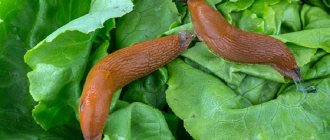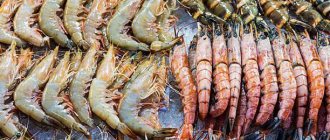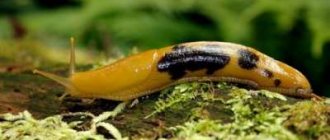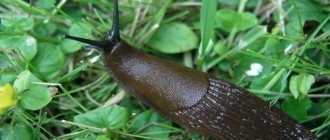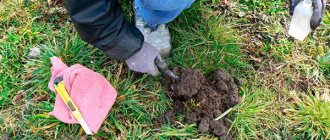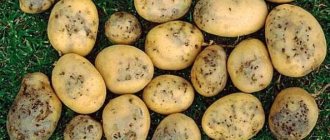What kind of slugs are there?
Slugs are gastropods, land mollusks.
There are several varieties of these pests:
- Slugs are oblong mollusks without a shell. Most often they have a grayish-yellow or earthy color. They are the ones who most often attack vegetable gardens and orchards.
- Half-slugs are recognized by their rudimentary shell.
- Snails are horned slugs with a shell. There are many varieties of snails: forest snail, variegated garden snail, common hairy snail, bush snail, and grape snail. They all differ in the color of the body and the shape and coloring of the shell.
Mollusks live for several years: snails - 3-4 years, slugs - 1-2 years. They become most active in the second half of summer. Parasites actively reproduce, laying eggs in dark and damp places. Most often, clutches, and even the slugs themselves, can be found under stones, old stumps, in compost, garbage and manure heaps, under old tree bark, etc.
Slugs and snails are mostly nocturnal and hide in secluded places during the day.
Mechanical limiters
Various objects (gutters, rims made of plastic or copper) are used as physical barriers to the spread of slugs. Small mounds of coarse sand, crushed egg shells, dried coffee grounds, to which soot, copper sulfate or even lime are also added, will help protect plants from creeping pests.
Headbands and covering material containing copper shock gastropods with electricity. Dry branches with nettle leaves, ropes smeared with tar or soaked in a solution of copper sulfate - all this is an insurmountable barrier for slugs. Obstacles are placed around beds or flower beds, and young plants are surrounded by rims.
The best results are achieved by comprehensive protection consisting of barriers, repellent plants and spraying.
What harm do they do?
Slugs feed on plant leaves. Moreover, they give the greatest preference to cultivated plants. Using their mouthparts, they devour soft tissue and gnaw holes in leaves, leaving mucus.
IMPORTANT! Moving from plant to plant, mollusks not only eat plant tissue, but also spread infection.
Mollusks feed on seeds, flower corms, berries (they especially like strawberries), cabbage and other vegetables. They do not disdain flowers and fruits if they can get to them. This is not to mention the leaves and stems of plants mentioned above.
We fight pests with biological means
There are a huge number of methods by which you can quickly and effectively remove unwanted neighbors from your suburban area.
Biological remedies for slugs in the garden in summer can be very effective. The best of them is considered Phasmarhabditis hermaphrodite. This substance is harmless to the environment, people and animals. To quickly get rid of parasites, you need to dilute a small amount of this component with water and spray the resulting mixture on the beds for a week.
Why do slugs and snails appear in the garden?
As mentioned above, slugs and snails are an important part of the ecosystem. In search of food and favorable conditions for growth and reproduction, slugs migrate between areas. If yours suits them, then they stay on it.
What does it mean? Slugs love moisture and warmth , and they also need shelter from the sun. If your site is waterlogged, there are many shady damp areas, boards are scattered, and stumps have not been removed, then with a high degree of probability you will encounter an invasion of slugs in the second half of summer.
Read more: How to get rid of wireworms in potatoes and root vegetables at your summer cottage
Pests can also enter the garden along with infected vegetables, cuttings, seedlings, etc.
The reason for the appearance of slugs - brief information
Slug (slug) is one of the most unpleasant pests that is found in the garden and vegetable garden. This is a gastropod mollusk of the stalked order, which in the process of evolution lost its shell, but acquired many skills that allow it to live and develop in the corresponding regions. It can be found anywhere with a mild climate, average or high humidity, and where there are food sources.
Despite their defenseless, soft-bodied appearance, slugs, having a grater tongue with sharp horn-like spines, are capable of grinding fruits and vegetables of any hardness (apples, potatoes, carrots, pumpkin).
If the summer is dry, the number of slugs and snails will be insignificant, but in a rainy, cool summer, mollusks can cause significant damage to the crop. In addition to direct destruction of crops, slugs, crawling from one plant to another, contribute to the spread of viral and fungal diseases - cabbage blight, potato late blight.
How to get rid of slugs using traditional methods
Unlike most insect pests, which are often only controlled by chemical insecticides, slugs can be controlled using traditional methods. The point here is that gastropods move only on the ground. Therefore, there are many ways to protect plants from them using simple traps and unique “barricades”.
REFERENCE. Most traditional methods take advantage of the main weakness of slugs - their soft and very sensitive body, which easily gets burned from contact even with not the strongest reagent.
How to use slaked lime
When shellfish invade your area, protect your plantings with slaked lime traps. Dilute it in water and pour a small stream into the improvised channels around the perimeter of the beds. This should be done after sunset, when the slugs become active. The mollusk crawls onto this “path” of lime and gets a chemical burn.
Pepper infusion against slugs
Use dried chilies or just buy ground pepper from the store. Pour 50 grams of the substance into a liter of cold water, leave for 2 days, then boil and leave again for two days. The resulting working solution is sprayed onto the plants before flowering.
Mustard powder for slugs
An infusion is made from mustard powder, which is sprayed on plants and watered on the ground around them. Mix 200 ml of water with a spoon of mustard, leave for an hour and add to 10 liters of water.
How to make bait traps
The next method is making bait traps. Place grated carrots, a piece of beetroot or leaves on the ground in a shady place. Cover the top with a rotten board or similar covering.
Periodically collect and destroy shellfish that have accumulated on your trap.
Wormwood infusion
This recipe will help not to destroy slugs, but to scare them away from plants . The fact is that mollusks cannot stand the smell of wormwood.
The tincture is prepared as follows.
Pick the wormwood and chop it finely with a knife. Then add water at the rate of 1 part wormwood to 5 parts water. Leave the mixture to ferment, stirring every day. In a month the infusion will be ready. Spray plants with it to protect against slugs .
IMPORTANT! Since the product is infused for 4 weeks, take care to prepare it in advance.
Catching slugs by hand
If there are not very many pests, then it makes sense to collect them manually. And then either destroy it or take it off site. But remember that it is better to wear gloves when collecting shellfish, as they leave sticky mucus on your hands.
Mulch for pests
Mulch as a remedy for slugs has been known since the 60s of the last century. Mulch plantings and row spacing, and then mollusks will not be able to get to your plants. Remember, the less smooth the surface, the harder it will be for slugs.
Does beer help with slugs?
You can fight shellfish using beer traps. You will need several half-liter plastic cups or plastic bottles cut in half and beer. Containers are dug in around the perimeter of the beds or some individual vegetables. You can bury the cups flush with the ground or just above the soil level. Then beer is poured into the container. The smell and taste of the drink attracts slugs. They crawl into glasses and drown in them.
Read more: Description and fight against the click beetle (wireworm) on potatoes
How to use baking soda
Baking soda can be used in two ways. The first is to sprinkle it on the pests in the discovered lair. This will cause instant death of the entire population. You can also prepare a solution for spraying: 5 liters of water, 50 grams of soda, 10 ml of liquid soap or shower gel.
Vinegar as a means of control
Vinegar is used in the same way. 65 ml of 9% vinegar is diluted in 10 liters of water and sprayed with a solution of slugs.
Are they afraid of ammonia?
Ammonia helps in the fight against harmful shellfish. 2 tablespoons of liquid are diluted in 5 liters of water and the plants are sprayed. The smell of ammonia is unbearable for gastropods, and they do not attack plants.
Slugs in the garden
Unfortunately, the range of gastronomic preferences of slugs is quite wide, which means that insidious mollusks are not limited to the garden. Some garden crops are also susceptible to attacks by the slippery pest.
Small black slugs on cherry or pear leaves are not slugs at all, but larvae of the cherry slimy sawfly. To get rid of this pest, plants are sprayed with Bitoxibacillin, Inta-C-M, Kinmiks, etc.
Slimy sawfly larva
Slugs on flowers
You might ask, “What do slugs eat in the garden?” Harmful mollusks are not averse to eating the tender pulp of ornamental plants. You can especially often find slugs on hostas: the mollusk gnaws at the base of the leaf (petiole), and it falls to the ground, and the pest receives both shelter and food. If you do not pay attention to damaged flower leaves in time, the entire flower garden can be significantly damaged.
In general, protecting against slugs in the garden is no different from controlling pests in the garden. The soil in the flower garden can also be sprinkled with Predator, Groza, etc., and water traps can be used. It is important to tie up spreading flowers so as not to create a “house” for slugs under the branches. A good remedy for snails and slugs is mulching the soil with drunken tea, coffee, peat, ash, and sand. These substances repel shellfish.
What medications are there for slugs and snails, table
Special chemical preparations for slugs are called molluscicides. You can find out which of them are most effective in the fight against gastropods from the table below.
| Means | Method of preparation and use |
| Mesurol | Scatter the granules over the beds of plants most affected by slugs. Keep away from children and animals. Work strictly with gloves |
| Nemaslug | Spray the plants and water the soil around them. Treat 2-3 times at intervals of 1-2 weeks |
| Unichem | The gel is applied around plants (effective for large bushes) or along the perimeter of the beds. Creates a coating that slugs cannot overcome |
| BROS | Spread the granules over the entire area at the rate of 80 grams per 10 sq. m. Use in the afternoon. Take care of plants |
| Groza-3 | Sprinkle the powder on the area at the rate of 30 grams per 10 square meters in places where shellfish accumulate or appear most frequently. |
| Slug eater | Sprinkle the powder on the site at the rate of 30 grams per 10 square meters in places where shellfish accumulate or appear most frequently, as well as along the beds and between the rows. |
| StopUlit | Place baits in front of the plants. Apply as needed |
| NEUDORFF Ferramol | 500 grams per hundred square meters. Sprinkle later in the evening. Apply no more than 4 times per season |
| Predator | Place the bait on the substrate. 1 package per 70 sq. m., at least 4 traps per 10 sq. m. |
| Ulicide | 500 grams per hundred square meters. Sprinkle later in the evening. Apply once per season |
| Meta | Sprinkle the powder on the site in places where shellfish accumulate or appear most frequently, as well as along the beds and between the rows. |
Slug trap
The fight against slugs with folk remedies is based on identifying the pest’s weak points and “competently” striking. As mentioned above, during the day slugs hide in shady places, and at nightfall they come out of their shelters in search of food. Build a trap to lure the shellfish and then dispose of them. It's very simple!
Beer as bait
Take disposable cups and dig them in several places in the garden bed so that the edges of the cup do not rise above the soil level. Pour some beer into each glass. Slugs are big fans of this intoxicating drink, despite the fact that it is harmful to them. By the morning you will find dead pests in the cups, and all that remains for you is to get rid of the bodies (some feed them to chickens). Such a trap should be installed in the late afternoon and covered during the daytime so as not to kill beneficial insects that are greedy for the bait.
Cabbage beds can be watered with warm water (40-50°C). But be careful - this method only works on cabbage! This water temperature can harm other crops.
Instead of beer, you can use other liquids that slugs are also not averse to profiting from: fermented compotes, juices, syrups. If you don't have cups, use flat containers with low sides.
False cover
Here's another remedy for slugs in the garden. Grease a wooden board with kefir or other fermented milk product and place it on two bricks or low stones with the greased side down. The slugs will smell a pleasant aroma and crawl towards the bait overnight. In the morning you will find a large number of pests under the board.
You can place pieces of roofing felt, linoleum or other material in the garden so that slugs can crawl under cover. By morning, many individuals will gather in such a trap.
Plants that repel pests
In order not to have to worry about preparing preparations for slugs and not to set traps, you can plant plants around the area whose smell repels pests.
These include onions and garlic, mustard, marjoram, wormwood, thyme, savory and some others. Plan the planting of these plants so that slugs do not have access to vegetable and berry crops.
Thyme
Folk recipes
Among the new ways to combat slugs, there are always folk recipes for exterminating slippery pests. In practice, folk recipes have proven their effectiveness and there are a large number of such methods, but we will focus on the most common and effective ones (Figure 9).
Figure 9. Folk remedies are considered completely safe, but no less effective than chemical ones
The following substances are useful for eliminating pests:
- Potassium salt: a solution is prepared on its basis in a proportion of 1 kg per 10 liters. The diluted liquid should be used to treat the plants and the soil around them.
- Ammonia: add 4 tablespoons to one bucket and spray the plants with the resulting solution.
- Garlic infusion: you need to chop 3 heads of garlic and pour them with 10 liters of water, and leave to infuse for a day. After 24 hours, you can start spraying the plants.
- Iron sulfate: this substance must be mixed with sand and sprinkled over the entire perimeter of the vegetable garden or garden plot. Upon contact with such a mixture, slugs will die.
- Mustard infusion: add 2 tablespoons of dry mustard to a glass of water, leave to infuse for one hour and dilute with half a bucket of water.
You will find more information about effective methods of fighting slugs in the video.
Mechanical methods of struggle
Mechanical methods of combating slugs and snails mean creating protective barriers that are insurmountable for mollusks.
You can block the path of slugs to your vegetables and berries by sprinkling the paths with a mixture of sawdust with ash, bark, and pine litter. Egg shells, coarse sand, etc. are also effective.
Read more: How to get rid of aphids on trees using traditional methods forever?
You can also bury coffee grounds under plants. The result will be both a death trap for shellfish and a nutritious food for plants.
Another rather expensive way to protect yourself from invasion is to lay covering material with a copper coating around the perimeter of the plot or beds, which generates a low-voltage current. However, even weak electricity causes significant damage to the mollusks, and they begin to avoid the area.
How to deal with slugs in the garden using mechanical methods
If you don’t want to use toxic chemicals right away, start with simple control methods. Despite their simplicity, they give good results.
Manual collection
Particularly effective in the morning. All favorite places where pests reside are inspected, and individuals are collected by hand. More often they live in damp, dark corners, on metal or wooden surfaces. These are the lower part of the porches, hoses and taps for watering, steel watering cans or buckets. Snails like to gather in the shade of plants: inside a strawberry rosette, under cabbage leaves. The collected gastropods are destroyed.
Baits and homemade traps
Hand picking is tedious and time consuming. To speed it up, they set traps and lay out bait. This makes it possible to collect several individuals in one place at once. We offer several options for traps that will help get rid of slugs.
- Gastropods like the smell of beer. It is poured little by little into plastic bottles with the neck cut off. The dishes are dug into the ground, leaving the cuts free. You can place such a bottle sideways on the ground. In both cases, the slugs will get inside and will not be able to get out.
- The soil under the future trap should remain dry for 4-5 days. In the evening, cardboard soaked in water, a board, slate, a rag or cabbage leaves are placed on it. Instead of water, you can take beer or kefir. In the morning, they raise the trap and collect the pests.
- Bait with corn works well. A little grain or flour from this crop is poured into a jar and dug into the ground, or laid on its side.
- Pests love all citrus and melon crops. Their crusts make good traps. A hole is cut out in the rind removed from half the fruit. Lay it cut side down on the ground. After some time, the gastropods are raised and collected.
All of these traps work well. They are used not only in the vegetable garden or garden, but also to combat slugs in the greenhouse.
Protective Barrier
A simple technique that prevents snails from entering an area. A protective strip is established around the vegetable garden or garden. To make it, they take rough or sharp materials that are uncomfortable for mollusks to crawl on. There are many options: crushed shells, coarse sand, crushed nut shells, slaked lime or wood ash. Dried coffee grounds, mustard powder and superphosphate help.
It is best to scatter the product not in one strip, but in several. The distance between them should be 150-200 mm. Garden trees or bushes are protected in the same way if they grow at a great distance from each other. A protective barrier is built around them. Gardeners note that copper and any materials containing it often help. When a slug's abdomen comes into contact with a copper-containing coating, a chemical reaction occurs that destroys the mucus. Pests do not like strong and spicy aromas. Therefore, plants with such a smell can be used as a deterrent barrier for greenhouses, cellars, and compost heaps. They are used to compact vegetable crops or sow along the perimeter of the beds. These are garlic, parsley, bay, marigold, rosemary and sage.
Prevention measures
As we said above, with rare exceptions, slugs do not attack well-groomed areas. The most important measure to prevent the appearance of these pests is to keep your garden, garden or summer cottage clean and tidy.
- Remove weeds, even if they are located at the edge of your garden.
- Loosen the soil more often. Try to ensure that it has a uniform structure.
- Attract birds to your garden. But not too hard, otherwise you’ll have to drive away the birds later.
- Maintain order in the area. Do not create piles of rotten boards, remove stumps, stones, etc.
- Digging up the soil in the fall, as mollusks hide in it for the winter.
- Do not allow your area to become over-watered.
Soda and salt
If slugs appear in the garden, it is not difficult to decide how to fight parasites with folk remedies. There are a lot of recipes.
Table salt is an excellent remedy that will help get rid of shellfish that have settled on the compost heap. As you know, they love to feast on rotting plant debris. To get rid of them, just scatter the components onto the compost pit in the evening. It should be borne in mind that the soda must be calcined.
To prepare a solution for spraying, just mix 50 grams of soda and 12 liters of water.
Common mistakes
Fighting slugs is a tedious and thankless task. Let's consider where and what mistakes gardeners make in this struggle.
- Ignoring the problem. Snails and slugs are often not taken seriously. Although they can cause no less problems than aphids or May and Colorado potato beetles. Therefore, it is very important to start fighting slugs as soon as you see the first individuals in your area.
- Slug-killing techniques are being used, although the area is a mess. The most important thing that a summer resident must do is to create conditions in which slugs cannot live and reproduce. The destruction of individual individuals is only a small part of the process of combating mollusks.
- Treatment with strong-smelling products during flowering. This scares away bees that fly away from the area.
- Inaccurate use of molluscicides. Firstly, the granules must not fall on the leaves and stems of plants. Secondly, when using chemical poison, be sure that children and animals will not reach it.
Fighting slugs on cabbage
At the very beginning of the article it was already noted that cabbage is a favorite delicacy of gastropods. Therefore, snails and slugs always attack planting sites of this crop. Often these parasites eat up early varieties at the root during the growth period. To protect the crop from pests and allow the head to form, you need to know how to plant cabbage seedlings correctly:
- Each plant is planted at a distance of at least 50 cm from each other. This layout will prevent the creation of overly moist areas on the site where slugs will feel comfortable.
- It is advisable to put a plastic ring on each bush, which can be cut from a bottle. Make notches along the edge of the ring with nail scissors so that the mollusk will injure its delicate body when trying to get close to the seedlings.
- When the lower leaves of the seedlings begin to form, they must be removed. This will limit pest access to young heads of cabbage.
- To repel parasites, you can spread wormwood and nettles between cabbage heads. Moreover, such natural barriers must be changed daily.
- As an additional means of protection, you should use evening watering of cabbage with hot water (+50°C). This crop can withstand this temperature well without getting burns. But hot water will instantly kill the slugs.
- Young cabbage seedlings must be sprayed with pepper infusion prepared according to the following recipe: grind red capsicum (100 g), soak the resulting pulp in 1 liter of water. Infuse for two days, then bring the solution to a boil and leave to infuse for another day. To process, you need to dilute 100 ml of the prepared infusion in a bucket of water, you can add soap shavings. Spray each bush.
To process cabbage on the site, you can use the following reliable means of combating mollusks: “Predator”, “Ferramol”, “StopUlit”, “Bros”. Mostly all slug control products come in the form of granules, which need to be evenly scattered in the area where the cabbage is planted.
Important!
You can only water cabbage with hot water. Such treatment is prohibited with other garden crops.
Answers to frequently asked questions
Is it necessary to control slugs on the site?
Yes, because otherwise they will multiply and cause irreparable damage to the harvest
Which product is most effective in fighting slugs?
The most effective way is to create unbearable living conditions for them. Otherwise, use molluscicides and slaked lime traps.
There are a lot of slugs in cabbage, what should I do?
Treat the plants with molluscicides (don't forget to add soap for sticking), and place traps around them.
How to prevent shellfish from appearing on your property?
Remove household and construction waste. Avoid accumulation of leaves, old branches, carrion, rot and stumps. Keeping the area clean is the key to pest-free areas. Also plant plants around the perimeter of the site whose smell is unbearable for shellfish.
Description of the pest
As children, we sang this song, not even knowing how much trouble this funny creature of nature could bring. Snails are voracious gastropods, which, when appearing on a site in large quantities, cause enormous damage to plants.
Types of slugs
The following gastropod pests are distinguished:
Basic information about garden slugs:
Gastropods lay eggs within 2-4 weeks after copulation in secluded corners of the garden:
One snail can lay up to 450 eggs. After laying eggs, 75% of the mollusks die. It takes an average of 36 days from egg laying to young slugs hatching. The first young individuals appear in September.
What do slugs eat?
Clams have thousands of tiny teeth on their tongues that crush food. Gluttons feed mainly at night, during the day they hide from the sun in shelters between stones, branches, leaves, and in the ground. By damaging plants, they cause great damage and spread diseases throughout the area.
Huge bulimia (gluttony) makes the slug one of the most dangerous pests of garden plants. They are omnivores, eating:
Benefits of snails
These gastropods play an important role in the garden ecosystem. In addition to their negative effects, they play many beneficial roles:
Gastropods are an important link in the food chain, so the decision to control slugs in the garden should only be made when the damage caused is severe.

